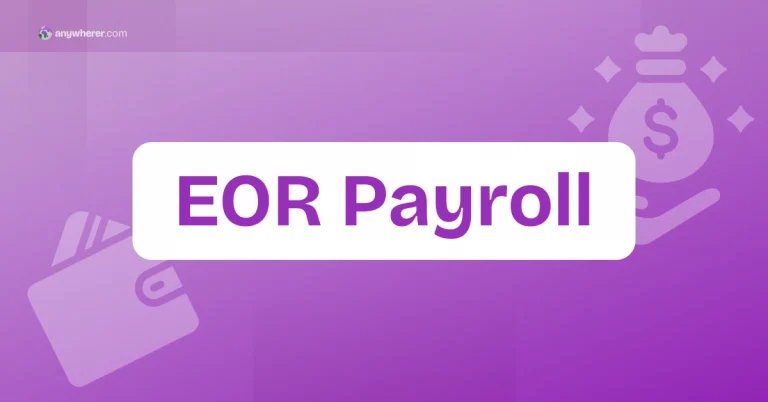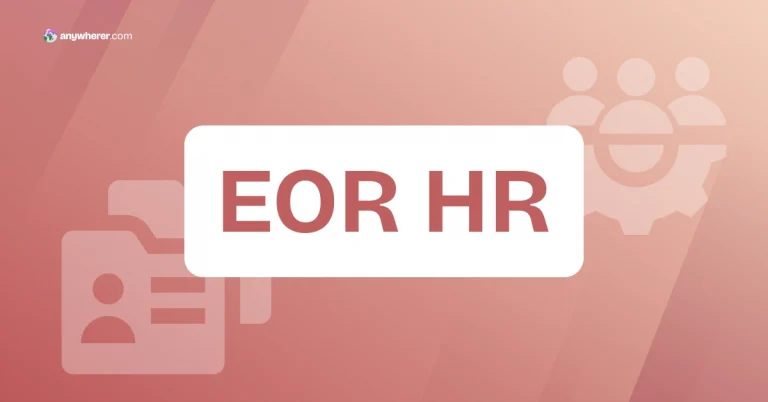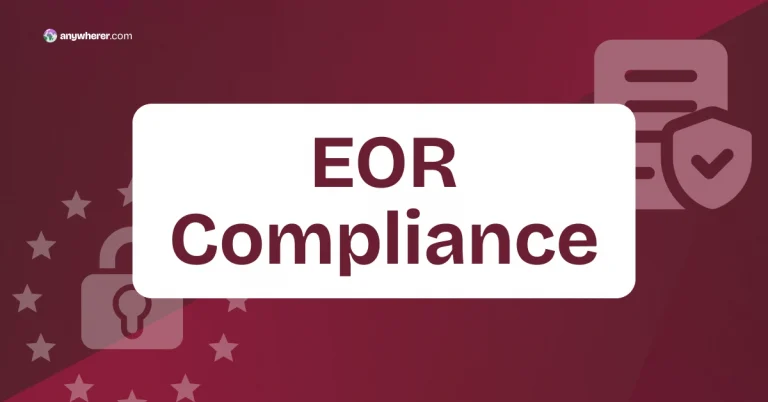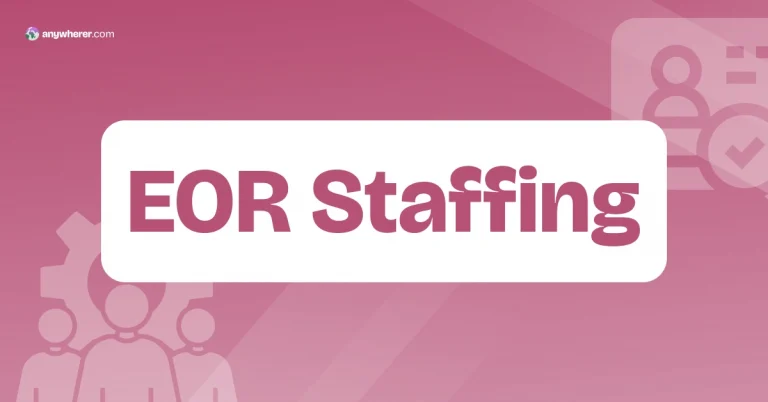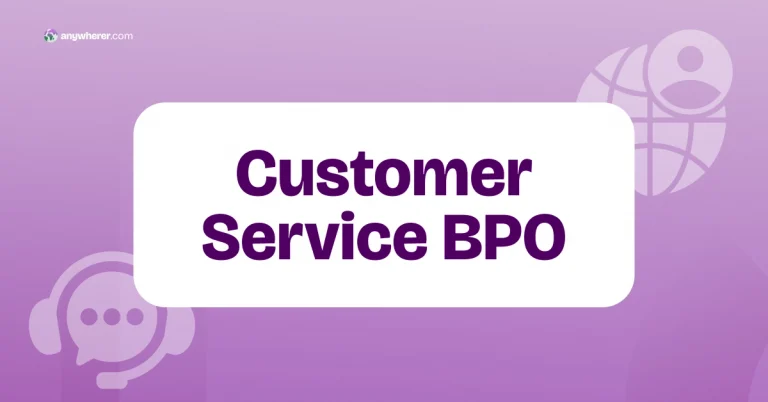The GDM meaning is the Global Delivery Model – a business model that enables service delivery between various global locations. But what is the meaning of GDM in practical terms? It’s a modern solution for companies looking to decentralize and expand efficiently. In contrast to models that focus services in a single place, the GDM model takes advantage of global time zones, cost benefits, and specialized expertise to maximize performance and responsiveness. It’s an arrangement tailored to the needs of today’s global economy, where round-the-clock availability, diverse areas of expertise, and cost control are critical.
GDM is a ubiquitous acronym for IT, consultancy, and customer service companies where speed, specialization, and scalability are the dominant themes. GDM enables companies to break down complex service processes into pieces that are serviceable and outsource them to teams based in the right locations worldwide.
What Does GDM Mean for Modern Global Service Delivery?
In effect, the value of GDM is essentially about maximizing business effectiveness with strategic deployment. Here’s how:
- Time zone coverage: Global staff enables 24/7 service availability and faster turnaround.
- Talent utilization: Leveraging more accurate skill sets with global access to labor markets.
- Cost optimization: Offshoring services to a low-overhead geography reduces the cost of service delivery.
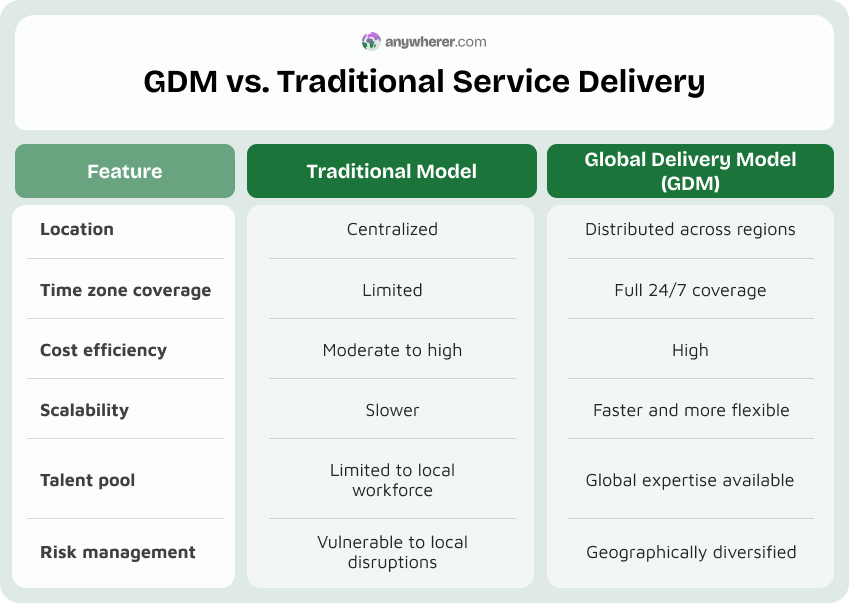
In contrast to the conventional IT service delivery model, which tends to work from one location or geographic area, the global service delivery model is stronger, more adaptable, and cost-effective.
Global Delivery Model Meaning
A service delivery approach that leverages teams located across multiple geographies to enhance scalability, reduce costs, and ensure continuous operations.
Key Building Blocks of the Global Delivery Model
The four pillars that form a successful GDM model are:
Onshore Delivery
Onshore delivery means the delivery of services from the home country of the client. This aspect entails the highest level of match of the client’s time zone, language, and business culture.
Strengths:
- Easy communication
- Very high quality
- Very small variation in time zones
Weaknesses:
- Higher operational and labor costs
- Less talent available for expertise skills
Nearshore Delivery
Nearshore delivery means the delivery of services from geographically proximate or neighboring countries with compatible working hours.
Strengths:
- Compatible time zones
- Lower cost than onshore
- Proximity to culture
Disadvantages:
- Lower talent pools than offshore
- Still might have some cost constraints
Offshore Delivery
Offshore delivery centers are located in far-away countries with very low operating costs, i.e., India, Philippines, or Ukraine. One of the major reasons for cost-effective global service delivery at low prices is this.
Advantages:
- Huge cost savings
- Access to large pools of differentiated talent
- Scalable operations
Disadvantages:
- Time zone differences
- Complexity in communication and management
- Data compliance risks
Hybrid Model
The hybrid model captures onshore, nearshore, and offshore dimensions. It is designed to optimize efficiency, control, and cost-saving and thus is one of the most popular models today.
Advantages:
- Flexibility and customization
- Increased risk sharing
- Enhanced cost-to-quality ratio
Disadvantages:
- Complex governance and coordination
- Requires experienced management and open process documentation
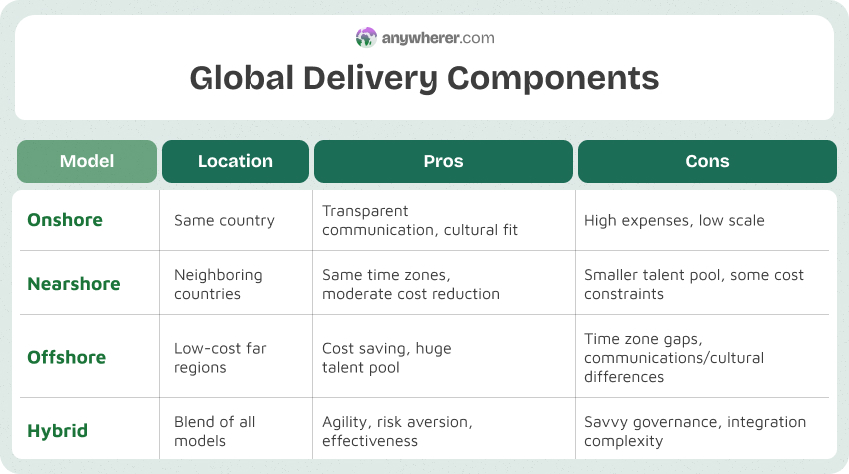
Global Delivery Model Operations
The following is a short outline of how organizations structure and run IT delivery model.
Establish Needs
Find pain points, delivery goals (e.g., 24/7 support, scalability), and internal capacity. Use GDM to scale rapidly, cross time zones, or access specialized skills.
Choose a Delivery Mix
Choose onshore, nearshore, offshore, or hybrid based on budget, control, risk, and customer needs. A hybrid is usually the best-balanced.
Choose Locations
Evaluate talent, expenses, infrastructure, and legal considerations. Refer to sources NASSCOM for India, OECD labor market conditions reports, or Statista outsourcing attractiveness indexes.
Choose an Engagement Model
To have a global delivery organization in place, companies must figure out how they are going to engage talent in every market. These may involve: captive centers, global PEO, international EOR, or BPO outsourcing. Each engagement model comes with a varying level of control, risk, and cost, which affects the way companies manage their global delivery services.
Set Governance and Communication
Recruit leads, automate workflows, use software like Jira and Slack, and define KPIs. Add performance monitoring and feedback loops.
Launch and Optimize
Deploy step by step. Monitor time to resolution, collaboration, satisfaction, and retention. Optimize before scale-up.
Benefits of Global Delivery Model and Its Drawbacks
The GDM definition highlights operational competence through geographic diversification but that does not render the strategy risk-free. As with any scalable process, GDM is intellectually its worth but bureaucratically difficult to control. The key to long-term success lies in knowing the recipe for attaining the right mix between the two.
Benefits of the Global Delivery Model
- 24/7 service availability: Multi-time zone workers facilitate round-the-clock operations, improving client responsiveness and project velocity.
- Access to worldwide talent: You are not bound by local hiring constraints; AI, DevOps, or domain specialists are at hand.
- Cost savings: Strategic nearshore and offshore roles minimize payroll and operations expenses.
- Scale: Teams can scale up or down depending on project requirements within a timely manner, making the approach extremely flexible.
- Risk transferring: Delivery across geography removes reliance on a point of failure and enhances business continuity.
- Fast time-to-market: Parallel workstreams and twenty-four-by-seven development cycles enable quicker product release.
Weak Points of the Global Delivery Model
- Time zone coordination: Misalignment may result in delays, meeting fatigue, and miscommunication.
- Cultural and language barriers: Divergent work styles, communication tone, and expectations may generate tensions.
- Data security and compliance: Global operations bring complexity in complying with local data protection acts (e.g., GDPR, PIPEDA).
- Management overhead: A successful global HR service delivery model has in place clear management, leadership, and regular tracking systems for remote teams.
- Team cohesion: Remote and hybrid work can impact firm culture and team bonding.
Solutions to Overcome GDM Challenges
- Take a hybrid overlap of time approach: Have 2–4 hours of overlapping availability daily per geography.
- Invest in cross-cultural training: Facilitate empathy and communication practice clarity.
- Partner with mature providers: Engage a mature international employer of record or global PEO to manage compliance and HR risk.
- Centralize workflows and documentation: Use Notion, Confluence, or ClickUp to create shared knowledge hubs.
- Establish bonding with virtual rituals: Celebrate successes everywhere, have global town halls, and create peer recognition.
The GDM abbreviation describes a model that has expanded to be a sophisticated yet high-impact method. Under the management of good management, it dishes up robust business value; in untrammeled form, it can soak operations.
Best Practices for a Successful Global Delivery Model
Acting on the global delivery model in reality implies strategic planning and implementation rather than adoption. The steps outlined below are also emblematic of underlying principles common to global leaders in outsourcing as well as service delivery.
1. Align GDM with Business Objectives
Align delivery objectives with business requirements, growth, 24/7 operations, or cost reduction, and tailor your strategy accordingly.
2. Choose the Right Delivery Partners
Work together with experienced international partners familiar with local markets, regulatory frameworks, and delivery operations. Review their reputation, pricing models, compliance expertise, and familiarity with the local market.
3. Standardize Tools and Processes
Use the same tools and templates for each team. Offer async workflows to support time zone differences.
4. Set Strong Governance
Appoint regional managers, have regular, consistent syncs, track KPIs, and leverage dashboards to keep operations on target.
5. Comply and Secure First
Ensure compliance with regulations, worldwide data training, and access controls. Deal with trusted vendors.
6. Invest in People and Culture
Empower leadership growth, equal pay, team building, and shared values. People get the job done, therefore treat them as such.
All these steps allow organizations to realize the full potential of global delivery model strategies by creating a strong, scalable, and people-centric operation.
Final Thoughts on the Global Delivery Model
The term GDM goes beyond outsourcing; it’s all about creating a cost-efficient, flexible, and agile service model. With the integration of onshore, nearshore, and offshore components, companies gain global scope without a hefty price label or longer delivery times.
We discussed the global delivery model meaning in detail, its components, setup process, as well as strategic advantages and disadvantages it offers. Organizations following global delivery model best practices, connecting operations to objectives, choosing the right partners, and establishing governance, achieve a real competitive edge.
Finally, the GDM model helps organizations expand wisely, work 24/7, and leverage specialized talent not available locally. Executed judiciously and clearly, it shifts from a delivery tool to a vehicle of international growth.
GDM Model FAQs: GDM Meaning, Use Cases, and Tools
What is global delivery model for business efficiency?
One of the primary strengths of global delivery model frameworks is increased efficiency through distributed services geographically as well as by time zones. This achieves 24/7 operations, faster turnaround, and cost savings through lower-cost geographical locations without compromising quality to the best level with centralized monitoring.
In which industries is GDM most commonly used?
Global delivery services are applied to sectors like IT, financial services, customer care, consulting, and healthcare. All of these sectors need 24/7 assistance, access to expertise, and scalable support.
What is the Global Delivery Model Structure and Its Key Elements?
The most important elements are onshore, nearshore, offshore, and hybrid delivery. Each of these integrates cost, talent access, responsiveness, and control within an elastic distributed model.
What is the optimum tool to execute a Global Delivery Model?
Executing a Global Delivery Model requires communication, collaboration, tracking, and compliance tools such as Slack, Jira, Confluence, Zoom, Vanta, or Okta.
What are a few good instances of effective Global Delivery Model implementations?
IBM, Accenture, TCS, and Infosys are typical examples of companies successfully utilizing the Global Delivery Model. These companies have made the GDM tag popular by offering high-quality, large-scale services in overseas markets.

Yaryna is our lead writer with over 8 years of experience in crafting clear, compelling, and insightful content. Specializing in global employment and EOR solutions, she simplifies complex concepts to help businesses expand their remote teams with confidence. With a strong background working alongside diverse product and software teams, Yaryna brings a tech-savvy perspective to her writing, delivering both in-depth analysis and valuable insights.

